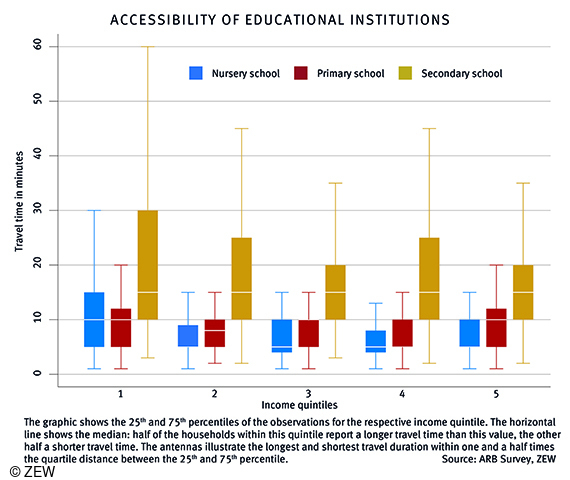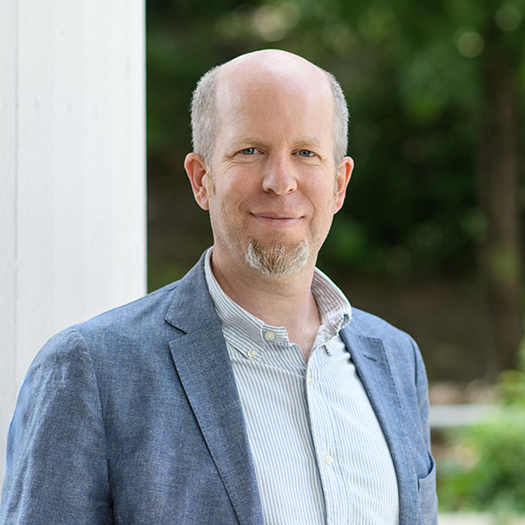Poorer Households Have on Average a Longer Travel Time to School
ResearchAccessibility of Educational Institutions
In Germany, low-income households need more time on average to get to nursery, primary and secondary schools. Although the time difference to more affluent households is usually only a few minutes each way, this means a significant additional time burden over the course of a year.
Those having to travel a longer distance are also less satisfied with their own living environment, as a current analysis by ZEW Mannheim together with the University of Göttingen shows. The analysis is based on data from the ARB Survey, which was conducted in 2018/2019 for the Sixth Poverty and Wealth Report (ARB) of the German government. For the statistical evaluation, the surveyed households were divided into five equally sized groups based on their income.
Poorest quintile takes 33 hours longer to get to school each year
The average travel duration to nursery school in Germany is just over seven minutes. However, while half of the children in the poorest 20 per cent of households need more than ten minutes to get to nursery school, this is true for no more than a quarter in the remaining 80 per cent. A longer travel time was also found when other factors, such as the difference between residence in urban and rural areas, were taken into account.
Similar correlations between household income and travel time have also been found for primary and secondary schools. On average, the trip to primary school takes nine minutes, with pupils from the poorest 20 per cent of households having longer journeys than all others. This correlation is particularly strong for secondary schools. The average journey to secondary school takes 18 minutes. Pupils from the poorest 20 per cent of households, on the other hand, live on average about five minutes longer away from the secondary school than all other households. “The differences for individual distances do not seem too great. However, with about 200 school days per year, the two times five minutes per day mean an additional time burden of 2,000 minutes, which is about 33 hours per year,” says ZEW researcher and study author Professor Holger Stichnoth.
“Children from wealthier households not only have larger social networks, supportive neighbourhoods and a higher cultural education. They also have more time over the year to spend on homework or hobbies. In urban and municipal development, political decision-makers should also take into account that all children have the same good access and equally long travel distances to school,” adds co-author Professor Claudia Neu from the University of Göttingen.
As the analysis by ZEW and the University of Göttingen further shows, those who live further away from schools are also less satisfied with their living environment. However, this is only the case when the travel distance is 15 minutes or more. Also, the further away households live from schools, the greater their desire that more investments be made in this regard. This correlation is particularly clear in the case of secondary schools: 19 per cent of households with a school commute of five minutes or less would like to see more investments being made. Among those who take more than 20 minutes, the share is twice as high at 38 per cent.
Wie die Analyse von ZEW und Universität Göttingen weiterhin zeigt, geht eine größere Entfernung mit einer geringeren Zufriedenheit mit dem Wohnumfeld einher, dies aber erst ab einer Wegstrecke von 15 Minuten. Und: Je weiter Haushalte von den Einrichtungen entfernt leben, desto größer ist ihr Wunsch nach mehr Investitionen in diesem Bereich. Dieser Zusammenhang wird vor allem bei weiterführenden Schulen deutlich: So wünschen sich 19 Prozent der Haushalte, die einen Schulweg von höchstens fünf Minuten haben, mehr Investitionen. Bei denen, die mehr als 20 Minuten benötigen, liegt der Anteil bei 38 Prozent und damit doppelt so hoch.
Distance to health care facilities depends on income
Access to other services of general interest such as health care or cultural offerings also depends on income. When asked about the distance to the nearest doctor or hospital, the poorest households report the longest distances. While half of the households in all income quintiles travel a maximum of ten minutes to the nearest doctor, journeys of 20 minutes or more occur mainly in the poorest quintile. Among these people, the desire to invest in health care infrastructure is particularly pronounced at 59 per cent. On the other hand, those who have a doctor at a maximum distance of five minutes or less are significantly less likely to see a need for further investment (29 per cent).
On average, the households surveyed live about 20 minutes away from the nearest cultural venue or event, such as a cinema or theatre. The median is also 20 minutes in four of the five quintiles. Only the richest quintile of households have the nearest cultural offering within a 15-minute distance. This is also true regardless of the size of the municipality and other factors in which the places of residence differ. Only 24 per cent of respondents see a need to invest in leisure facilities, and this is largely independent of the distance to the nearest cultural venue.

